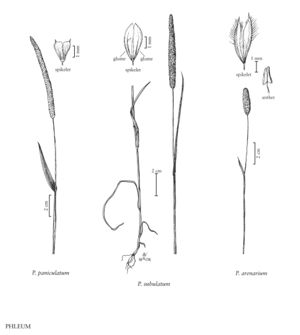familyPoaceae
subfamilyPoaceae subfam. Pooideae
tribePoaceae tribe Poeae
genusPhleum
speciesPhleum arenarium
Difference between revisions of "Phleum arenarium"
imported>Volume Importer |
imported>Volume Importer |
||
| Line 43: | Line 43: | ||
|publication year= | |publication year= | ||
|special status=Introduced | |special status=Introduced | ||
| − | |source xml=https://bitbucket.org/aafc-mbb/fna-data-curation/src/ | + | |source xml=https://bitbucket.org/aafc-mbb/fna-data-curation/src/200273ad09963decb8fc72550212de541d86569d/coarse_grained_fna_xml/V24/V24_951.xml |
|subfamily=Poaceae subfam. Pooideae | |subfamily=Poaceae subfam. Pooideae | ||
|tribe=Poaceae tribe Poeae | |tribe=Poaceae tribe Poeae | ||
Latest revision as of 16:26, 11 May 2021
Plants annual. Culms 2-35 cm. Sheaths of the flag leaves inflated; auricles not developed; ligules 1.5-3 mm, rounded to acute; blades 1-5(7) cm long, 1.5-5 mm wide, flat or folded. Panicles 0.5-5.5 cm long, 3-7 mm wide, ovoid to shortly cylindrical, cuneate at the base, widest at or above midlength. Glumes 2.2-4.4 mm, oblong-lanceolate, keels ciliate, tapered, apices parallel or divergent, awns 0.3-1 mm, usually parallel, sometimes divergent; lemmas about 1/3 as long as the glumes, glabrous or pubescent; anthers 0.3-1.2 mm. 2n = 14.
Distribution
N.Y., N.J., Mass., Oreg.
Discussion
Phleum arenarium is native to maritime sands and shingles of southern and western Europe. It is known only from old ballast dump records in the Flora region.
Selected References
None.
Lower Taxa
None.
